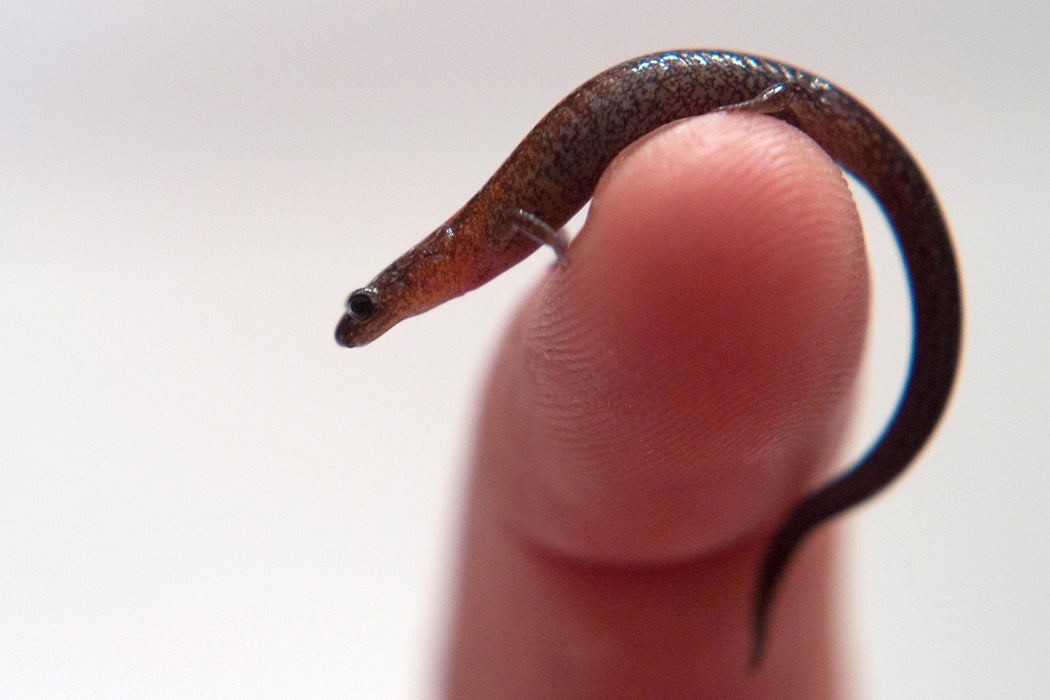In 2009, climate journalist Elizabeth Kolbert first reported on the mysterious and precipitous decline of frog populations in El Valle, Panama, which were long a defining icon of the region’s biodiversity. (A Spanish-language version of her article appeared in an issue of Política Exterior later that year.) She further explored the crisis in her 2014 Pulitzer Prize-winning book The Sixth Extinction, which presented a damning account of a new (sixth) epoch of mass extinction—this one driven by human activity. The culprit behind the mass frog die-offs at the turn of the century? A previously unknown fungus, Batrachochtryium dendronbatidis (Bd for short), now thought to have hitched a ride around the world via global trade of the African clawed frog (Xenopus laevis) as an exotic pet in the mid-twentieth century.
Bd doesn’t completely account for the rapid decline of other amphibian populations, however, like that of endearing but oft-overlooked salamanders. But salamanders, the closest living relatives of frogs, haven’t been immune to Bd, either, and they’re now also under threat from a related fungus, B. salamandrivorans (Bsal). Since being identified in 2013, Bsal has afflicted native salamander populations in Asia and spread invasively to similar climes in western Europe, including the Netherlands and Norway. In a recent study published in Diversity and Distributions, Michael Moubarak and his research team write that Bd and Bsal are estimated to have infected more than 1300 amphibian species. Both cause the infectious disease chytridiomycosis, characterized by skin lesions and rapid death—in lab studies, salamanders infected with Bsal died within seven days, after bouts of anorexia, apathy, and ataxia (degeneration of the nervous system).
Given the volume of exotic salamander trade in the US—nearly 800,000 salamanders, almost all exotic, were traded between 2010 and 2014, according to a team led by research conservationist Tiffany A. Yap—scientists consider it only a matter of when, not if, Bsal will appear in North America and begin ravaging native salamander populations. This would be particularly devastating, suggests Yap et al., given that North America is the world’s salamander biodiversity hotspot, home to about half of the 676 recognized species (190 species in the US and 137 in Mexico alone). In anticipation of the danger Bsal presents to North American populations, the US Fish and Wildlife Service banned the importation of 201 species of salamanders in 2016, naming them as injurious wildlife.

Moubarak et al. characterize the salamander species and regions of North America as most susceptible to Bsal by using machine learning models trained on the spread and distribution of Bsal in Asia and Europe. The team modeled and extrapolated ecological niches and traits of salamander species in the United States that might be favorable hosts for Bsal. They found that in both the native and invasive range of Bsal, the most suitable places were close to coastlines or on islands, such as Vietnam, Taiwan, and Norway. In the US, ecological niches in the Pacific Northwest, Florida, the Gulf and Atlantic coasts, and the Appalachian Mountains most resemble the Asian and European niches and are thus most likely to be favorable environments for Bsal.
The models predicted that twelve salamander species in the US would be most susceptible to Bsal infection, though four of the species haven’t had infections observed to date. As extrapolated from already-infected species, the study found that salamander species that host Bsal tend to have intermediate body sizes and lifespans compared to other species, perhaps due to “less robust immune function compared to larger- or longer-lived individuals.” Species with larger clutch sizes also tended to be more susceptible to infection, which the researchers surmised is related to “lower investment in immune function.” These species also tend to spend more time in water during mating, likely enabling the spread of the aquatic fungus.
Weekly Newsletter
But it’s not all bad news for North American salamanders in the face of Bsal spread. Moubarak’s team found that their model “predicted an overall less suitable environment for Bsal in the United States than in Europe and Asia,” with “moderate suitability in some coastal areas” akin to the coasts of Norway, one of the places in Europe where Bsal became invasively established. And, likely as a result of the US Fish and Wildlife Service’s aggressive and early ban, a large-scale survey in 2020 still detected no Bsal in North America across more than 11,000 samples in thirty-five US states and one site in Mexico. A statistical model also indicated that Bsal “is highly unlikely to occur within wild amphibians in the US,” especially given continued bans and mitigation efforts.
“The best proactive response,” the ecologists counsel, “is to continue mitigation efforts against the introduction and establishment of the disease and to develop plans to reduce impacts should Bsal establish.”







